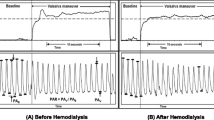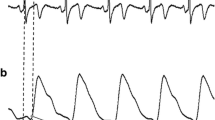Abstract
Background: Peripheral arterial tonometry and Ultrasound measurement of flow mediated dilation have been the widely reported noninvasive techniques to assess vasodilation during reactive hyperemia (RH). Objective: Simultaneous monitoring of dilatation and tone of the vasculature during RH induced by venous occlusion (VO) and arterial occlusion (AO) has been presently attempted using simple noninvasive measures of photoplethysmography (PPG). Methods: Finger-PPG characteristics that include pulse timings, amplitude, upstroke-slope and pulse transit time (PTT) were studied before (1 min), post-VO (5 min) and post-AO (5 min) in 11 healthy volunteers. Results: PPG amplitude was significantly increased to maximum at 2nd min of post-AO (1.28±0.11 vs. 1.0 nu, P<0.05) as compared to the baseline; meanwhile, no significant changes (P>0.05) in PPG amplitude was observed during post-VO. Tremendous increase in PTT was evident at 1st min of post-AO (196.6±3.3 vs. 185.3±3.6 ms, P<0.0001) and was maintained significantly longer through 1–5 min of post-AO. Relatively small but significant increase in PTT was noticed only at 1st min of post-VO (193.9±6.8 vs. 189.6±6.2 ms, P<0.0001), followed by an immediate recovery to baseline by 2nd min of post-VO. The increase in PTT (i.e. ΔPTT) was higher at 1st min of post-AO (11.4±1.3 vs. 4.3±1.1 ms) as compared to post-VO. Conclusion: Results suggests that PTT response reflects the myogenic components in the early part of RH and PPG amplitude response reflects the metabolic component reinforcing the later course of RH. PPG amplitude and PTT can be used to quantify the changes in diameter and tone of the vessel wall, respectively during RH. The collective responses of PPG amplitude and PTT can be more appropriate to facilitate PPG technique for monitoring of vasodilation caused by RH.
Similar content being viewed by others
References
Celermajer DS, Sorensen KE, Gooch VM, et al. Non-invasive detection of endothelial dysfunction in children and adults at risk of atherosclerosis. Lancet. 1992;340:1111–5.
Ishibashi Y, Takahashi N, Shimada T, et al. Short duration of reactive hyperemia in the forearm of subjects with multiple cardiovascular risk factors. Circ J. 2006;70:115–23.
Itzhaki S, Lavie L, Pillar G, et al. Endothelial dysfunction in obstructive sleep apnea measured by peripheral arterial tone response in the finger to reactive hyperemia. Sleep. 2005;28:594–600.
Kuvin JT, Patel AR, Sliney KA, et al. Assessment of peripheral vascular endothelial function with finger arterial pulse wave amplitude. Am Heart J. 2003;146:168–74.
Pyke KE, Tschakovsky ME. Peak vs. total reactive hyperemia: which determines the magnitude of flow-mediated dilation? J Appl Physiol. 2007;102:1510–9.
Baldassarre D, Amato M, Palombo C, Morizzo C, Pustina L, Sirtori CR. Time course of forearm arterial compliance changes during reactive hyperemia. Am J Physiol Heart Circ Physiol. 2001;281:H1093–103.
Vanhoutte PM. Endothelium and control of vascular function: state of the art lecture. Hypertension. 1989;13:658–67.
Guyton AC, Hall JE. Text book of medical physiology. 11th ed. Philadelphia: Saunders; 2006.
Corretti MC, Anderson TJ, Benjamin EJ, Celermajor D, Chorbonneau F, Creager MA, et al. Guidelines for the ultrasound assessment of endothelial-dependent flow-mediated vasodilation of the brachial artery-a report of the international brachial artery reactivity task force. J Am Coll Cardiol. 2002;39:257–65.
Kuvin JT, Patel AR, Sliney KA, et al. Peripheral vascular endothelial function testing as a non-invasive indicator of coronary artery disease. J Am Coll Cardiol. 2001;38:1843–9.
Takase B, Uehata A, Akima T, et al. Endothelium-dependent flow-mediated vasodilation in coronary and brachial arteries in suspected coronary artery disease. Am J Cardiol. 1998;82:1535–9.
Bonetti PO, Lerman LO, Lerman A. Endothelial dysfunction: a marker of atherosclerotic risk. Arterioscler Thromb Vasc Biol. 2003;23:168–75.
Iiyama K, Nagano M, Yo Y. Impaired endothelial function with essential hypertension assessed by ultrasonography. Am Heart J. 1996;132:779–82.
Harris KF, Mathews KA. Interactions between autonomic nervous system activity and endothelial function: a model for the development of cardiovascular disease. Psychosom Med. 2004;66:153–64.
Chowienczyk PJ, Kelly RP, MacCallum H, et al. Photoplethysmographic assessment of pulse wave reflection blunted response to endothelium-dependent Beta2-Adrenergic vasodilation in Type II Diabetes Mellitus. J Am Coll Cardiol. 1999;34:2007–14.
Hayward CS, Kraidly M, Webb CM, Collins P. Assessment of endothelial function using peripheral waveform analysis—a clinical application. J Am Coll Cardiol. 2002;40:521–8.
Wilkinson IB, Hall IR, MacCullum H, et al. Pulse-wave analysis clinical evaluation of a noninvasive, widely applicable method for assessing endothelial function. Arterioscler Thromb Vasc Biol. 2002;22:147–52.
Allen J. Photoplethysmography and its application in clinical physiological measurement. Physiol Meas. 2007;28:R1–39.
Challoner AVJ. Photoelectric plethysmography for estimating cutaneous blood flow. In: Rolfe P, editor. Noninvasive physiological measurement, vol. I. London: Academic press; 1979. p. 125–51.
Nijboer JA, Dorlas JC, Mahieu HF. Photoelectric plethysmography-some fundamental aspects of the reflection and transmission method. Clin Phys Physiol Meas. 1981;2:205–15.
Lund F. Digital pulse plethysmography (DPG) in studies of the hemodynamic response to nitrates-a survey of recording methods and principles of analysis. Acta Pharmacol Toxicol. 1986;59:79–96.
Millasseu SC, Guigui FG, Kelly RP, Prasad K, Cockcroft JR, Ritter JM, et al. Noninvasive assessment of the digital volume pulse: comparison with the peripheral pressure pulse. Hypertension. 2000;36:952–6.
Gopaul NK, Manraj MD, Hebe A, Lee Kwai Yan S, Johnston A, Carrier MJ, et al. Oxidative stress could precede endothelial dysfunction and insulin resistance in Indian Mauritians with impaired glucose metabolism. Diabetologia. 2001;44:706–12.
Millasseau SC, Kelly RP, Ritter JM, Chowienczyk PJ. Determination of age-related increases in large artery stiffness by digital pulse contour analysis. Clin Sci. 2002;103:371–7.
Ruiz-Vega H, Benitez G, Carranza-Madrigal J, Huape-Arreola MS. Evaluation of vasodilator effects by means of changes of photoplethysmographic pulse waveshape. Proc West Pharmacol Soc. 1998;41:73–4.
Zahedi E, Jaafar R, Ali MA, Mohamed AL, Maskon O. Finger photoplethysmogram pulse amplitude changes induced by flow-mediated dilation. Physiol Meas. 2008;29:625–37.
Lane HA, Smith JC, Davies JS. Noninvasive assessment of preclinical atherosclerosis. Vasc Health Risk Manag. 2006;2:19–30.
McEniery CM, Wallace S, Mackenzie IS, McDonnell B, Yasmin, Newby DE, et al. Endothelial function is associated with pulse pressure, pulse wave velocity and augmentation index in healthy humans. Hypertension. 2006;48:602–8.
Johansson A, Ahlstrom C, Lanne T, Ask P. Pulse wave transit time for monitoring respiration rate. Med Biol Eng Comput. 2006;44:471–8.
Naschitz JE, Bezobchuk S, Mussafia-Priselac R, Sundick S, Dreyfuss D, Khorshidi I, et al. Pulse transit time by R-wave-gated infrared photoplethysmography: review of the literature and personal experience. J Clin Monit Comput. 2004;18:333–42.
Foo JYA, Lim CS. Pulse transit time as an indirect marker for variations in cardiovascular related reactivity. Technol Health Care. 2006;14:97–108.
Carlsson I, Sollevi A, Wennmalm A. The role of myogenic relaxation, adenosine and prostaglandins in human forearm reactive hyperaemia. J Physiol. 1987;389:147–61.
Jaryal AK, Selvaraj N, Santhosh J, Anand S, Deepak KK. Monitoring of cardiovascular reactivity to cold stress using digital blood volume pulse characteristics in health and diabetes. J Clin Monit Comput. 2009;23:123–30.
Imms FJ, Lee WS, Ludlowt PG. Reactive hyperemia in the human forearm. Q J Exp Physiol. 1988;73:203–15.
Tee GB, Rasool AH, Halim AS, Rahman AR. Dependence of human forearm skin postocclusive reactive hyperemia on occlusion time. J Pharmacol Toxicol Methods. 2004;50:73–8.
Nakajima K, Tamura T, Miike H. Monitoring of heart and respiratory rates by photoplethysmography using a digital filtering technique. Med Eng Phys. 1996;18:365–72.
Holsinger WP, Kempner KM, Miller MH. A QRS preprocessor based on digital differentiation. IEEE Trans BME. 1971;18:212–7.
Usui S, Amidror I. Digital low-pass differentiation for biological signal processing. IEEE Trans BME. 1982;29:686–93.
Medow MS, Taneja I, Stewart JM. Cyclooxygenase and nitric oxide synthase dependence of cutaneous reactive hyperemia in humans. Am J Physiol Heart Circ Physiol. 2007;293:H425–32.
Selvaraj N, Jaryal AK, Santhosh J, Deepak KK, Anand S. Assessment of heart rate variability derived from finger-tip photoplethysmography as compared to electrocardiography. J Med Eng Technol. 2008;32:479–84.
Maltz JS, Budinger TF. Evaluation of arterial endothelial function using transit times of artificially induced pulses. Physiol Meas. 2005;26:293–307.
Author information
Authors and Affiliations
Corresponding author
Additional information
Selvaraj N, Jaryal AK, Santhosh J, Anand S, Deepak KK. Monitoring of reactive hyperemia using photoplethysmographic pulse amplitude and transit time.
Rights and permissions
About this article
Cite this article
Selvaraj, N., Jaryal, A.K., Santhosh, J. et al. Monitoring of reactive hyperemia using photoplethysmographic pulse amplitude and transit time. J Clin Monit Comput 23, 315–322 (2009). https://doi.org/10.1007/s10877-009-9199-3
Received:
Accepted:
Published:
Issue Date:
DOI: https://doi.org/10.1007/s10877-009-9199-3




